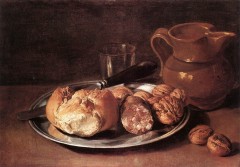Feeding and Housing the Boston Massacre Jury
Normally a jury would produce minimal expenses. Even murder trials were supposed to be over in a day. After jurors retired to discuss their verdict, they weren’t given any food or drink. That motivated a quick decision, and thrifty New Englanders no doubt also appreciated the savings.
The Massacre trials were different. To be scrupulously fair, the parties and surrounding society agreed that those sessions could extend over days in order to hear from many witnesses and learned counsels.
As a result, the jurors had to be provided with meals and beds overnight. In addition, the Massachusetts Superior Court asked the Suffolk County magistrates to provide “a reasonable Allowance” to those men to compensate them for their time.
In 1897, John Noble (1829-1909), longtime clerk of the state’s Supreme Court, showed the Colonial Society of Massachusetts a bill detailing the expenses of maintaining the jury. The society printed a transcript and most recently posted that online.
The document was headed “Mr. Joseph Mayo To Joseph Otis on Acct of the Soldiers Tried of ye 29th Regt.” Mayo was the foreman of the jury in the soldiers’ trial. Otis was keeper of the Boston jail, but his duties also included many courthouse tasks, including “Tolling the Bell, Sweeping the Court Chamber, making Fires for the Courts,” and even “bottoming Chairs for Jurymen.”
The invoice shows that on the first day of the trial, 27 November, the jurymen started to eat together and sleep away from their homes. The expenses cover “Biskett & Cheese & Syder” or “Bread Cheese & Syder” in the middle of each day, “Breakfast” every morning starting on 28 November, and “Supper” every evening until 4 December, the day before the trial ended. Breakfast and supper were for fourteen men—presumably the jurors plus two court officers.
From 27 November to the morning of 5 December, the expenses covered “Lodging” for twelve men. That included Sunday, 2 December, when there was no court session (and no bread, cheese, and cider at midday). Lodging cost £1.4s. Old Tenor for those jurors compared to £4.4 for breakfast and £7.17.6 for supper.
Also included were “Pipes & Tobacco”; “Fireing 8 Nights for ye officers” of the court, possibly sitting up to keep the jurors sequestered; and “Sperites Licker,” details frustratingly vague.
The invoice totaled almost £17 in up-to-date Massachusetts money. As written, it implied that Mayo owed that sum to Otis, recompensing him for those expenditures. But people must have agreed that the court system would pay the bill. Justices of the peace Eliphalet Pond, Joseph Williams, and Ebenezer Miller signed the document to authorize payment from the Suffolk County treasury.
Additionally, in February 1771 the Superior Court granted jailkeeper Otis “Four Pounds for his extraordinary care & trouble in attending the several Courts of Justice, for the Year past, they having sat a much longer time than usual.”
As for the jurors’ time, in May 1771 all the county justices heard arguments about whether to compensate those men. They decided that without a law to guide them, they didn’t have the authority to make such a payment. Again, the system wasn’t designed yet for multi-day trials.



